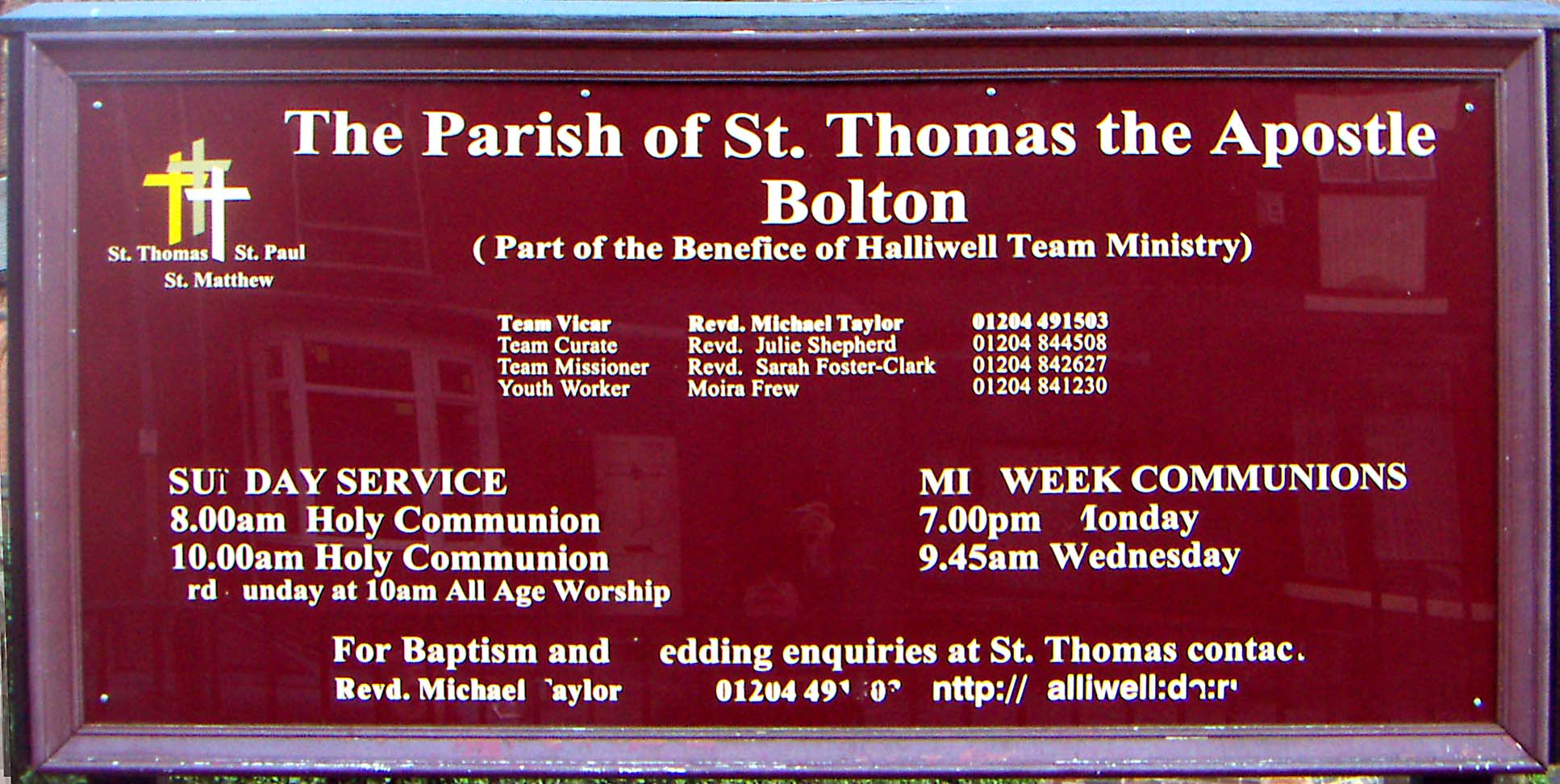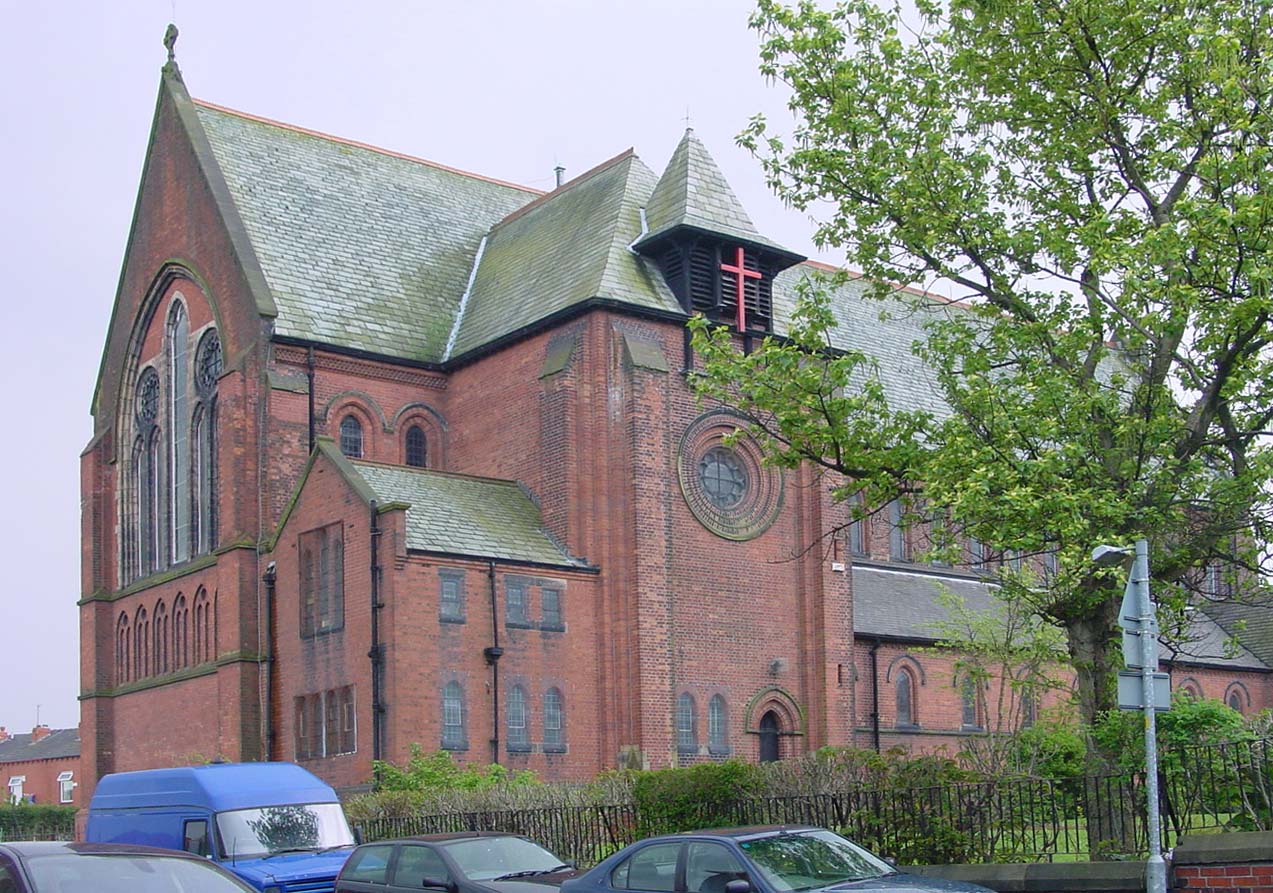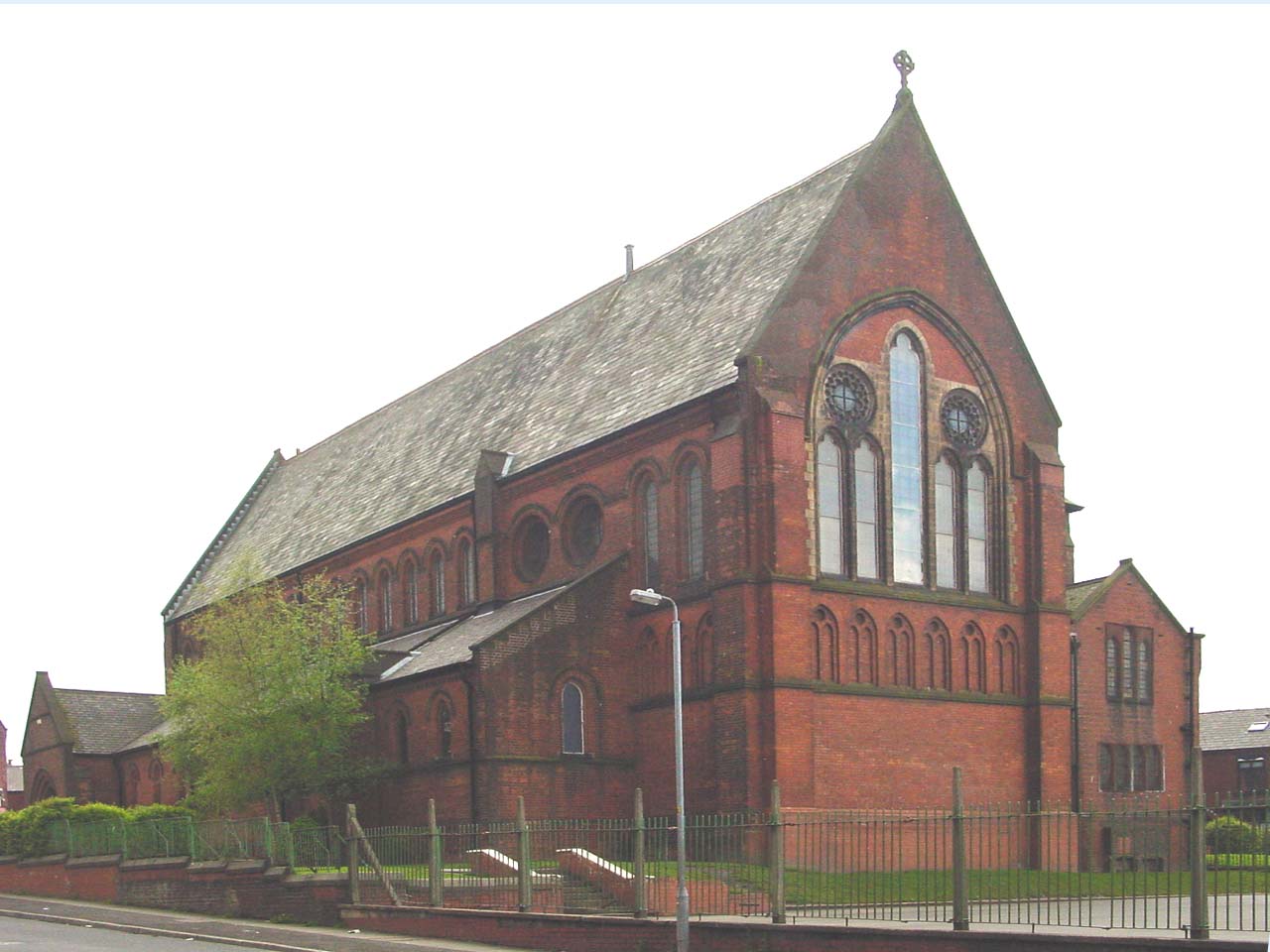 |
The
Church of St Thomas the Apostle, Halliwell |
 |
 | |
 | |
 | |
From The Bolton Journal, Saturday, November 27 1886, reproduced here by the kind permission of the Bolton News.
The Church of St. Thomasís, Halliwell, which is situate off Halliwell-road, was consecrated in July, 1875, by the late Dr. Fraser, Bishop of Manchester. It was built from designs by Messrs. Paley and Austin, the eminent architects, the contractor being Mr. Cottam, of Croston. It is built of local brick, and shows unplastered brick inside. It consists of a nave, five bays long, 87ft. by 28ft. 6in. with north and south aisles, chancel 38ft. by 28ft.-in., with vestry and organ chamber above. It provides accommodation for 765 worshippers, 100 of the sittings being free. The cost has been about £7,000, and there is an endowment of £30 per annum, the gift of the late Mr. Thomas Cross, J.P., of Ruddington Hall, Notts. The church is the outcome of the liberality of several gentlemen connected with the Halliwell district. About 1870 the necessity of increased church accommodation being provided was brought under the notice of Mr. R.H. Ainsworth, J.P., of Smithills Hall who offered to enlarge St. Paulís Church, and plans were drawn for additional accommodation to seat 300 persons. At this juncture Mr. Thomas Cross, J.P., then residing at Mortfield, offered to give land for a church, parsonage, and school, and £1,000 towards the erection of a new church at the opposite end of the parish. The then Vicar of St. Paulís (the Rev. A. Packer) persuaded Mr. Ainsworth to postpone the enlargement of St. Paulís Church, and transfer his donation to the erection of St. Thomasís Church, and to this he consented. Subscriptions were asked for among the friends of St. Paulís, and the sum of £4,000 was promised in a few days. It was subsequently found that £1,000 would be required to complete the building, and the following handsome donations were at once forthcoming: Mr. J.P. Cross, Mr. Herbert Shepherd-Cross (now M.P. for the borough), the late Mr. N. Greenhalgh, and Mr. W. Tristram £400 each, and Mr. R.H. Ainsworth £300. The present Vicar at St. Thomasís is the Rev. Alex. Glen-Bott, who succeeded the Rev. A.T. Mitton, M.A.
From The Bolton Journal and Guardian, Friday, October 22 1937, reproduced here by the kind permission of the Bolton News.
The close proximity of those three Anglican Churches Ė St. Thomasís, St. Paulís (Halliwell) and St. Matthews Ė sometimes leads one to wonder whether the decision to build them so close together was altogether a wise one. The active parochial life of each of the three, however, offers a firm reassurance on this point.
Up to 1875 there was only one church to serve the Halliwell district Ė St. Paulís. But by 1876 it had become obvious that this church, which accommodates no more than 500 worshippers, was too small for the growing population of Halliwell.
And, the problem was very nearly solved without the erection of another church. The first scheme put forward, in fact, was for the enlargement of St. Paulís church, and had this taken place, the consecration of St. Matthewís in 1876 would probably have meant that St. Thomasís would never have been built.
It is not surprising that when churchmen began to realize that Halliwell needed increased church accommodation they should approach Mr. R.H. Ainsworth, J.P., of Smithills Hall, who was noted for his support of the Church of England. It is indeed to the Ainsworth family that Halliwell owes two of its churches Ė St. Peterís and St. Paulís.
He offered to enlarge St. Paulís Church, and this apparently appeared to be the best solution, for plans were drawn up for the extension of that church. These plans would have increased the accommodation at St. Paulís to 800. But they were never carried out.
There were others who apparently felt that the need would be more effectively met by the erection of another church a little nearer town. So before the plans for the extension of St. Paulís were put in hand, Mr. Thomas Cross, who was then living at Mortfield, came forward with a generous offer which led to the erection of St. Thomasís Church.
He was no doubt thinking about the desires of many of the people who lived on the Brownlow Fold side of the parish, for in the early seventies apart from a mission church, the predecessor of St. Matthewís, there was no Anglican church between St.Peterís and St. Paulís on the one side and St. Georgeís on the other.
He came forward with an offer of a plot of land, which is now occupied by St. Thomasís, as a site for a new church, school and vicarage. He also promised £1,000 towards the erection of a church at this end of St. Paulís parish.
The problem then was to reconcile the two schemes of Mr. Ainsworth and Mr. Cross. Much naturally depended upon the Vicar of St. Paulís, who was most likely to be affected by the formation of a new parish which would mean the cutting down of the size of his parish.
The Vicar of St. Paulís at this time, however, was a man of considerable vision, the Rev. A. Packer, and he was in favour of the formation of a new parish. He undertook to see Mr. Ainsworth, and was able to persuade him to put off the enlargement of St. Paulís and transfer his donation to the new church. From all accounts, however, it was not Mr. Packerís idea that the extension to his own church should never take place.
One report states that Mr. Packer persuaded Mr. Ainsworth to ďpostponeĒ the enlargement of St. Paulís, thus evidently leaving the way open for the offer to be renewed at an early date. But the extension never took place, and so St. Thomasís gain was St. Paulís loss.
Members of St. Paulís congregation were appealed to for support for the new church and in the course of a few days £4,000 was promised. It was subsequently discovered, however, that a further £1,900 would be required to complete the building and further large donations were received almost immediately. These included the following: Mr. J.P. Cross, Mr. Herbert Shepherd Cross (afterwards M.P. for Bolton), Mr. N. Greenhalgh and Mr. W. Tristram £400 each; Mr. R. H. Ainsworth £300.
The total cost of St. Thomasís Church was about £7,000. It was consecrated in July, 1875, by the Bishop of Manchester, Dr. Fraser. The architects were Messrs. Paley and Austin.
It is a well-proportioned building in local brick, with a spacious interior providing accommodation for 765 worshippers.
Evidence that under the present Vicar, the Rev. J.W. Bridgeman, there is an active parochial life is the fact that recently the day school was extended at a cost of £6,500.
St. Thomasís is in every sense a thriving parish. Incidentally it has had only three vicars, the Rev. A.T. Mitton, the Rev. A. Glen-Bott, and Mr. Bridgman.
| Bolton Home & Contents | ©Lancashire OnLine Parish Clerks | Lancashire Home |